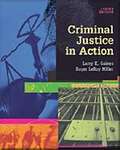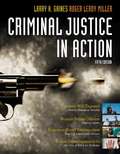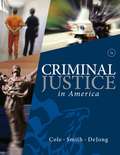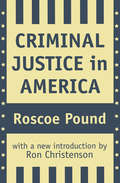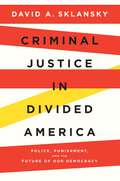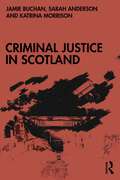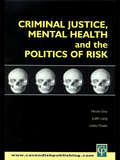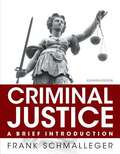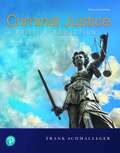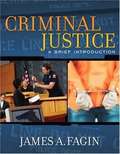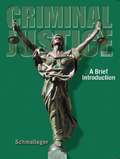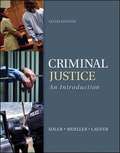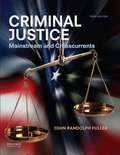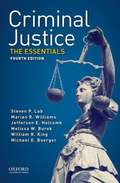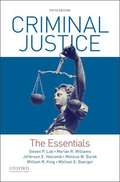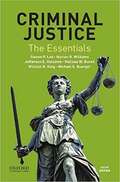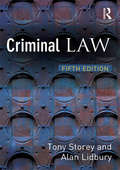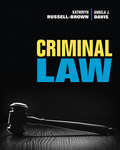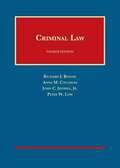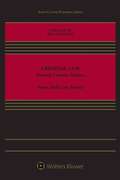- Table View
- List View
Criminal Justice in Action (3rd Edition)
by Roger Leroy Miller Larry K. GainesThis textbook introduces the criminal justice system and particularly examines the roles played by police, courts, and corrections. Gaines (California State University) and Miller discuss measurements and explanations of crime, criminal law, police organization, pretrial procedures, criminal trials, punishment and sentencing, probation and community corrections, juvenile justice, the drug war, and cybercrime. The fifth edition adds a chapter on homeland security and sections on police strategies, jail overcrowding, and school violence. Annotation ©2008 Book News, Inc. , Portland, OR (booknews. com)
Criminal Justice in Action: The Core (Criminal Justice Ser.)
by Larry K. Gaines Roger LeRoy MillerNIMAC-sourced textbook
Criminal Justice in America (7th Edition)
by George F. Cole Christopher E. Smith Christina DejongThe book is designed to provide thorough introduction and comprehensive coverage to the dynamics of the American criminal justice system and illuminates contemporary issues and problems.
Criminal Justice in America (Quality Paperbacks Ser.)
by Roscoe PoundRoscoe Pound believed that unless the criminal justice system maintains stability while adapting to change, it will either fossilize or be subject to the whims of public opinion. In Criminal Justice in America, Pound recognizes the dangers law faces when it does not keep pace with societal change. When the home, neighborhood, and religion are no longer capable of social control, increased conflicts arise, laws proliferate, and new menaces wrought by technology, drugs, and juvenile delinquency flourish. Where Pound saw the influence of the motion pictures as part of the "multiplication of the agencies of menace," today we might cite television and the Internet. His point still holds true: The "old machinery" cannot meet the evolving needs of society. In Criminal Justice in America,Pound points out that one aspect of the criminal justice problem is a rigid mechanical approach that resists change. The other dimension of the problem is that change, when it comes, will result from the pressure of public opinion. Justice suffers when the public is moved by the oldest of public feelings, vengeance. This can result in citizens taking the law into their own hands--from tax evasion to mob lynchings--as well as in altering the judicial system--from sensationalizing trials to producing wrongful convictions. Ron Christenson, in his new introduction, discusses the evolution of Roscoe Pound's career and thought. Pound's theories on jurisprudence were remarkably prescient. They continue to gain resonance as crimes become more and more sensationalized by the media.Criminal Justice in America is a fascinating study that should be read by legal scholars and professionals, sociologists, political theorists, and philosophers.
Criminal Justice in Divided America: Police, Punishment, and the Future of Our Democracy
by David A. SklanskyHow a broken criminal justice system has fueled the crisis of American democracy, and how we can address both problems together.American criminal justice is in crisis. Prisons are swollen, confidence in police has plummeted, and race- and class-based biases distort every aspect of the system. American democracy is in crisis, too, as the chasm of loathing and incomprehension that divides political factions grows ever wider and deeper. Legal scholar and former prosecutor David A. Sklansky argues that these crises are deeply intertwined. And if the failures of American criminal justice are near the heart of our political divides, then reforming the system is essential for repairing our democracy.Criminal Justice in Divided America shows how police, courts, and prisons helped to break American democracy and how better approaches to public safety and criminal accountability can help to repair it. Engaging critically with concerns from both the left and the right, Sklansky lays out a clear and deeply researched agenda for reforming police departments, prosecutors’ offices, criminal trials, and punishment. Sklansky seeks pragmatic solutions that take account of political realities: the lofty ideal of empowering “the people” or “the community” can mean little when members of the public or the community disagree. While efforts to “defund” the police have exacerbated political conflicts without addressing the underlying problem of how and when force should be used to protect public safety, reforms aimed at improving police accountability, restraining prosecutorial power, and expanding the role of juries can bring together warring parties who share a concern for justice.Ultimately, Sklansky argues, reform must be rooted in a strong commitment to pluralism—bridging political divides rather than worsening them, strengthening democracy, and securing the broad support that enables durable change.
Criminal Justice in Hong Kong
by Carol Jones Jon VaggContaining a wealth of archival material and statistical data on crime and criminal justice, Criminal Justice in Hong Kong presents a detailed evaluation of Hong Kong’s criminal justice system, both past and present. Exploring the justice system and the perceptions of popular culture, this book demonstrates how the current criminal justice system has been influenced and shaped over time by Hong Kong’s historical position between ‘East’ and ‘West’. Jones and Vagg’s examination of the justice system not only takes into account geographical changes, like the erection of the border with communist China in 1950 but also insists that any deep understanding of the current system requires a dialogue with the rich and complex narratives of Hong Kong’s history. It explores a range of questions, including: How were Hong Kong's criminal justice institutions and practices formed? What has been its experience of law and order? How has Hong Kong's status as between 'East' and 'West' affected its social, political and legal institutions? Careful and detailed, this analysis of one of the most economically successful, politically stable and safe yet frequently misrepresented cities, is a valuable addition to the bookshelves of all undergraduate and postgraduate students studying Asian law.
Criminal Justice in Scotland
by Jamie Buchan Sarah Anderson Katrina MorrisonProviding a comprehensive and up-to-date introduction to the contemporary Scottish criminal justice system, this book focuses on its key processes (from arrest to post-sentence) and institutions, as well as its history and some of the key challenges and critical issues facing Scottish criminal justice today.Highly attentive to procedural and institutional detail, this book is underpinned by a critical sociological perspective. The opening chapter considers Scotland in its post-devolutionary context within the UK, setting the scene for Scottish criminal justice institutions. Subsequent chapters deal in turn with different institutions and processes of Scottish criminal justice: surveillance and crime prevention, policing, prosecution and the courts, criminal fines and other financial penalties, community justice, electronic monitoring, prisons, youth justice, and parole and post-sentence reintegration and supervision. The final chapter draws on comparative and international criminology to look at Scottish criminal justice in changing international contexts and its response to new global crimes.Designed to support learning, it includes the following: Key ideas at the start of each chapter, outlining expectations and providing a very high-level summary of the most important points Text boxes covering key issues, controversies and/or key populations in focus Critical questions to challenge students to develop their own thinking and ideas about key issues in Scottish criminal justice Short, informal interviews with key practitioners and researchers Essential readings and key resources at the end of each chapter Criminal Justice in Scotland is a key text for students of criminology and criminal justice, particularly those with an interest in the Scottish criminal justice system. It will also be of value to students of law, social work and social policy.
Criminal Justice, Mental Health and the Politics of Risk
by Lesley Noaks Nicola S Gray Judith M LaingCriminal Justice, Mental Health and the Politics of Risk addresses the important issues which lie at the forefront of decision making and policy in criminal justice and health care. The book brings together several perpectives from a number of distinguished academic lawyers, criminologists, psychologists and psychiatrists. It is multi-disciplinary in its approach and is jointly edited by a lawyer, a criminologist and a psychologist - all of whom have expertise and experience in this field. The book is written in the light of the current emphasis on risk assessment and management as well as the recent government proposals to reform mental health law and detain dangerous and severely personality disordered individuals. It provides a theoretical overview for academics and students in the fields of medical law, mental health law, criminal justice, psychology, sociology, criminology and psychiatry. In addition, the book's highly topical and pragmatic approach will appeal to numerous professionals and practitioners
Criminal Justice: A Brief Introduction
by Frank J. SchmallegerThe gold standard for criminal justice texts Criminal Justice: A Brief Introduction, Eleventh Edition offers a contemporary, authoritative look at crime in America with a focus on police, courts, and corrections. To make information resonate with students, Schmalleger asks readers to consider the balance between freedom and security issues and evaluate the strengths and weaknesses of the American justice system as it adapts to cultural, political, and societal changes. An interactive website along with author tweets (@schmalleger) extends chapter material and provides up-to-the minute information on this ever-evolving field. Its unifying theme, unmatched timeliness, and coverage of trends and technology make this text the standard by which all other brief texts are judged. Personalize learning with MyCJLab MyCJLab is an online homework, tutorial, and assessment program designed to work with this text to engage students and improve results. This powerful homework and test manager lets you create, import, and manage online homework assignments, quizzes, and tests that are automatically graded. You can choose from a wide range of assignment options, including time limits, proctoring, and maximum number of attempts allowed. The bottom line: MyLab means less time grading and more time teaching.
Criminal Justice: A Brief Introduction
by Frank SchmallegerCriminal Justice is the gold standard of criminal justice texts. It examines crime in the US, with a focus on police, courts and corrections. You'll contemplate the fine line separating freedom from security and evaluate the strengths and weaknesses of the US justice system. A wealth of internet resources along with author tweets (@schmalleger) build on central ideas in the text, while keeping pace with a continually changing field. The revised 13th Edition emphasizes the need for systemic change. It includes revised coverage of large-scale crimes pervasive in the US, as well as policing issues and challenges, sentencing guidelines, and state laws redefining the age of criminal responsibility.
Criminal Justice: A Brief Introduction
by James A. FaginA 12-chapter, paperback brief text that is realistic, applied and practical. Criminal Justice: A Brief Introduction is a realistic, applied, and practical text,which introduces students to the real world of criminal justice. Fagin uses clear and simple examples drawn from decades of experience to bring criminal justice alive for students. With a clear and readable style,the author places the criminal justice system in the broader context of American government. James Fagin is a recognized educator in the administration of justice; an expert in areas of contemporary concern, such as transnational terrorism, computer crime, and computer technologies in criminal justice; and has hands-on experience in law enforcement.
Criminal Justice: A Brief Introduction (6th Edition)
by Frank SchmallegerCriminal Justice: A Brief Introduction 6e continues to offer a trusted, authoritative and impeccably researched introduction to the criminal justice system in America. This book's freedom vs. safety theme, its unmatched timeliness, and its coverage of the newest criminal justice trends and technology helps readers think critically about the criminal justice system in a time when the issue of freedom vs. safety has never been more critical. The book's primary theme discusses the balance of freedom and safety between our society and the criminal justice system. Terrorism and security issues include up-to-date coverage of police terrorism response, including the most recent information on counter terrorism initiatives by America's police. Other hot topics include all the latest crime statistics, court cases, trends in the system and criminal justice news. Extensive coverage of technology and crime includes the latest law enforcement technology used to combat crime and technology used by criminals to commit crimes. Also includes extensive discussion of the juvenile justice system. For anyone with current or future criminal justice careers or those in law enforcement positions.
Criminal Justice: A Brief Introduction (9th Edition)
by Frank J. SchmallegerThe first and BEST-SELLING brief introduction to criminal justice text, Criminal Justice: A Brief Introduction 9e offers instructors and students a trusted, authoritative and impeccably researched introduction to police, courts, and corrections. Designed with a new visual approach, this edition integrates graphic art with the important concepts and ideas of criminal justice. Its unifying theme, its unmatched timeliness and its coverage of trends and technology makes this text THE standard by which all other brief texts are judged.
Criminal Justice: An Introduction 6th Edition
by Freda Adler Gerhard O. W. Mueller William S. LauferCriminal Justice: An Introduction offers a current, lively and thorough introduction to criminal justice. Students are easily drawn to the intriguing field with coverage of past developments, contemporary issues, and tomorrow's challenges. This edition offers new material on diversity in the Criminal Justice System to help students better understand the system from the perspective of women and minorities. Manageable in terms of size and price, Criminal Justice: An Introduction offers a concise and affordable option to your Criminal Justice course.
Criminal Justice: Mainstream and Crosscurrents
by John FullerCriminal Justice: Mainstream and Crosscurrents uses a distinctive crosscurrents theme to teach students about the complexities of the criminal justice system--and help them think critically about critical issues.
Criminal Justice: The Essentials
by Steven P. Lab William R. King Marian R. Williams Michael E. Buerger Melissa W. Burek Jefferson E. HolcombA flexible and cost-effective alternative to larger texts, Criminal Justice: The Essentials, Fourth Edition, covers all the fundamental issues faced by law enforcement, the courts, corrections, and juvenile justice, leaving detailed specifics and tangential topics to the discretion of instructors to cover in class.<p><p> With abundant examples--and just the right amount of sidebars and "highlights"--Criminal Justice, Fourth Edition, is an excellent resource for introducing students to the essential issues in the field. Visit the Companion Website for a wealth of student and instructor resources.
Criminal Justice: The Essentials
by Steven P. Lab William R. King Marian R. Williams Michael E. Buerger Melissa W. Burek Jefferson E. HolcombCriminal Justice: The Essentials, Fifth Edition, covers all the fundamental issues faced by law enforcement, the courts, corrections, and juvenile justice, leaving detailed specifics and tangential topics to the discretion of instructors to cover in class. With abundant examples and just the right amount of sidebars and "highlights" Criminal Justice, Fifth Edition, is the ideal resource for introducing students to the essential issues in the field.
Criminal Justice: The Essentials
by Steven LabA flexible and cost-effective alternative to larger texts, Criminal Justice: The Essentials, Sixth Edition, covers all the fundamental issues faced by law enforcement, the courts, corrections, and juvenile justice, leaving detailed specifics and tangential topics to the discretion of instructors to cover in class. With abundant examples-and just the right amount of sidebars and "highlights," Criminal Justice, Sixth Edition, is the ideal resource for introducing students to the essential issues in the field.
Criminal Law
by Tony Storey Alan LidburyThis textbook covers the Criminal Law option of the A-level law syllabus, and provides an ideal introduction for anybody coming to the subject for the first time. Criminal Law covers all A-level syllabuses/specification requirements, and is written by the principal examiner and principal assistant examiner in Criminal Law for one of the major examination boards. It contains extensive case illustration, and a range of examination related questions and activities. There is a special focus on key skills, and on the new synoptic assessment syllabus requirements. This fully updated third edition builds upon the success of the first two editions. It: provides coverage of OCR and AQA specifications is endorsed by OCR for use with the Criminal Law option includes new OCR synoptic assessment source materials (for use in examinations in June 2005) with additional guidance discusses new legislation and cases including Sexual Offences Act 2003, Andrews, Bollom, G and R, Rowland, Safi and others, Weller, Z.
Criminal Law
by Katheryn Russell-Brown Angela J. DavisAn Interdisciplinary Approach Criminal Law provides students with an integrated framework for understanding the U.S. criminal justice system with a diverse and inclusive interdisciplinary approach and thematic focus. Authors Katheryn Russell-Brown and Angela J. Davis go beyond the law and decisions in court cases to consider and integrate issues of race, gender, and socio-economic status with their discussion of criminal law. Material from the social sciences is incorporated to highlight the intersection between criminal law and key social issues. Case excerpts and detailed case summaries, used to highlight important principles of criminal law, are featured throughout the text. The coverage is conceptual and practical, showing students how the criminal law applies in the "real world"—not just within the pages of a textbook.
Criminal Law
by Katheryn Russell-Brown Angela J. DavisAn Interdisciplinary Approach Criminal Law provides students with an integrated framework for understanding the U.S. criminal justice system with a diverse and inclusive interdisciplinary approach and thematic focus. Authors Katheryn Russell-Brown and Angela J. Davis go beyond the law and decisions in court cases to consider and integrate issues of race, gender, and socio-economic status with their discussion of criminal law. Material from the social sciences is incorporated to highlight the intersection between criminal law and key social issues. Case excerpts and detailed case summaries, used to highlight important principles of criminal law, are featured throughout the text. The coverage is conceptual and practical, showing students how the criminal law applies in the "real world"—not just within the pages of a textbook.
Criminal Law
by Angela J. Davis Katheryn K. RussellCriminal Law, Second Edition provides your students with an understanding of the U.S criminal justice system, using a sociological framework that illustrates how criminal law and the justice system impact the real world. Throughout the text, case excerpts and detailed summaries highlight key principles of criminal law, offering a thorough and engaging exploration of complex concepts.
Criminal Law
by Angela J. Davis Katheryn K. RussellCriminal Law, Second Edition provides your students with an understanding of the U.S criminal justice system, using a sociological framework that illustrates how criminal law and the justice system impact the real world. Throughout the text, case excerpts and detailed summaries highlight key principles of criminal law, offering a thorough and engaging exploration of complex concepts.
Criminal Law
by Peter Low John Jeffries Richard Bonnie Anne CoughlinThis casebook features rigorous analysis of legal doctrine positioned against a backdrop of cultural and political debate. Its core is the act and mental state requirements of both the common law and the Model Penal Code. Topics of current interest include sexual assault, stand-your-ground laws, battered woman’s syndrome, the insanity defense, and capital punishment. The chapter on liability for the conduct of another is completely new. It integrates treatment of two doctrinal paths to that result, complicity and conspiracy, beginning with the Supreme Court’s 2014 Rosemond decision and combining consideration of other doctrines common to both.
Criminal Law
by Janis L. Kirkland; Kimberly R. Van EssendelftCriminal Law 2nd Edition Revised Custom Edi
